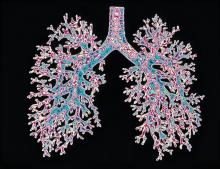A study aimed at determining whether behind some of the sex differences in chronic obstructive airway disease (COPD) prevalence and clinical outcomes lie structural differences in airways found that airway lumen sizes quantified through chest CT were smaller in women than in men.
The findings, published in Radiology, took into account height and lung size. for equivalent changes, compared with men.
Among key findings in a secondary analysis of consecutive participants (9,363 ever-smokers and 420 never-smokers) enrolled in the Genetic Epidemiology of COPD (COPDGene) study, airway lumen dimensions were lower in never-smoker women than in men (segmental lumen diameter, 8.1 mm vs. 9.1 mm; P < .001). Also, ever-smoker women had narrower segmental lumen diameter (7.8 mm ± 0.05 vs. 8.7 mm ± 0.04; P < .001). The investigators found also that a unit change in wall thickness or lumen area resulted in more severe airflow obstruction, more dyspnea, worse respiratory quality of life, lower 6-minute walk distance, and worse survival in women, compared with men.
While COPD is diagnosed more often in men than women, changes in smoking behavior and increasing urbanization have led to COPD prevalence in women fast approaching the rate in men. Although age-adjusted rates for COPD-related deaths have continued to decline in men, in women they have not. Indeed, never-smoking women accounted for two-thirds of COPD in a population-based study.
COPDGene, a prospective, multicenter, observational cohort study, enrolled current and former smokers, as well as never-smokers, aged 45-80 years at 21 clinical centers across the United States from January 2008 to June 2011 with longitudinal follow-up until November 2020. The investigators quantified airway disease through CT imaging using the following metrics: airway wall thickness of segmental airways, wall area percent of segmental airways, the square root of the wall area of a hypothetical airway with 10-mm internal perimeter, total airway count, lumen diameter of segmental airways, airway volume, and airway fractal dimension.
“Not all sex differences in prevalence of COPD have been explained, and structural differences may explain some of these differences. Our findings may have implications for patient selection for clinical trials,” corresponding author Surya P. Bhatt, MD, associate professor of medicine and director of the University of Alabama Imaging Core at Birmingham, said in an interview.
The investigators wrote: “Our findings have implications for airflow limitation and the consequent clinical outcomes. ... We confirmed that men have more emphysema than women with equivalent smoking burden, and our results suggest that the lower reserve conferred by smaller airways predisposes women to develop airflow limitation predominantly through the airway phenotype. All airway remodeling changes were associated with more dyspnea, worse respiratory quality of life, and lower functional capacity in women than in men. The smaller airways in women can result in higher airway resistance and more turbulent airflow, and thus place a higher ventilatory constraint during exertion. Alteration in each airway measure was also associated with worse survival in women than in men, partially explaining the comparable mortality between the sexes for COPD despite the differing degrees of emphysema.”
“I think these findings highlight underappreciated sex differences in the natural history of COPD,” Mohsen Sadatsafavi, MD, PhD, associate professor, faculty of pharmaceutical sciences, at the University of British Columbia, Vancouver, said in an interview. “To me, first and foremost, the Bhatt et al. findings highlight how the ‘one size fits all’ approach to COPD management of using exacerbation history alone to guide preventive therapies is incorrect. These findings have the potential to change the management paradigm of COPD in the long term, but before getting there, I think we need to relate these findings to clinically relevant and patient-reported outcomes.”
Noting study limitations, the authors stated that a higher proportion of men were active smokers, compared with women, and despite adjustments for smoking status, some of the airway wall differences may be from the impact of active cigarette smoking on airway wall thickness.
Five study authors reported receiving support from various government and industry sources and disclosed conflicts of interest based on relationships with industry. The rest reported no conflicts of interest.


